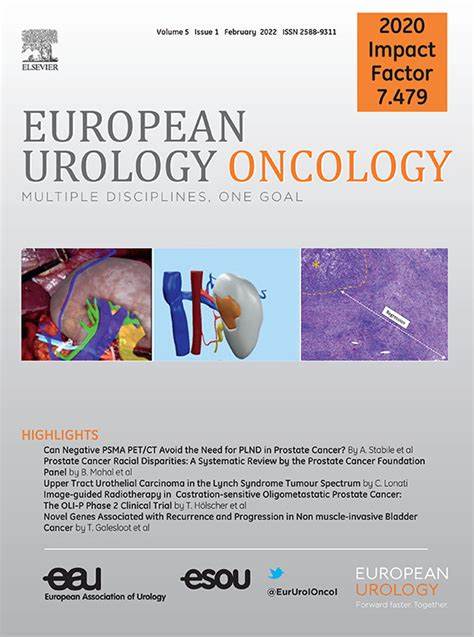评估卡介苗-谷氨酰胺-无反应的非肌肉侵袭性膀胱癌临床试验中治疗时间方案的影响。
IF 9.3
1区 医学
Q1 ONCOLOGY
引用次数: 0
摘要
卡介苗(BCG)无反应性(UR)非肌肉浸润性膀胱癌(NMIBC)患者不适合或拒绝根治性膀胱切除术,可采用保膀胱治疗(BST)。目前,大多数BST试验在BCG-UR设定中要求在组织病理学确认后60-90天内开始治疗。鉴于缺乏最佳治疗窗口的数据,我们评估了这些时间限制是否具有肿瘤学价值。我们回顾性地回顾了在三级转诊中心接受BST治疗的BCG-UR NMIBC患者的资料。使用Kaplan-Meier分析评估常用的临床试验截止时间。还进行了多变量Cox回归分析,包括治疗时间作为连续变量。无进展生存期(PFS)是主要终点,定义为进展为肌肉侵袭性疾病或转移。使用30 d、60 d和90 d截止时观察到类似的PFS(均p < 0.05)。这些结果在调整BST类型的多变量分析中得到证实。次要终点,包括无膀胱切除术生存期和总生存期,在治疗时间间隔内具有可比性(均p < 0.05),研究结果得到多变量分析的支持。这些结果表明,基于治疗时间的纳入标准可能会扩大,这将允许更多的患者参与临床试验,避免提前期排除。本文章由计算机程序翻译,如有差异,请以英文原文为准。
Assessing the Impact of Treatment Timing Protocols in Clinical Trials for Bacillus Calmette-Guérin–unresponsive Non–muscle-invasive Bladder Cancer
Patients with bacillus Calmette-Guérin (BCG)-unresponsive (UR) non–muscle-invasive bladder cancer (NMIBC) who are ineligible for or decline radical cystectomy may pursue bladder-sparing therapy (BST). Currently, most BST trials in the BCG-UR setting mandate treatment initiation within 60–90 d of histopathologic confirmation. Given the lack of data on optimal treatment windows, we evaluated whether these time restrictions have oncologic merit. We retrospectively reviewed data for patients with BCG-UR NMIBC treated with BST at a tertiary referral center. Commonly used clinical trial cutoffs for time to treatment were assessed using Kaplan-Meier analysis. Multivariable Cox regression analysis was also performed, with time to treatment included as a continuous variable. Progression-free survival (PFS) was the primary endpoint, defined as progression to muscle-invasive disease or metastasis. Similar PFS was observed when using 30-d, 60-d, and 90-d cutoffs (all p > 0.05). These results were corroborated on multivariable analysis with adjustment for BST type. Secondary endpoints, including cystectomy-free survival and overall survival, were comparable across time-to-treatment intervals (all p > 0.05), with findings supported by multivariable analyses. These results indicate that inclusion criteria based on time to treatment can probably be expanded, which would allow more patients to participate in clinical trials by avoiding leadtime exclusion.
求助全文
通过发布文献求助,成功后即可免费获取论文全文。
去求助
来源期刊

European urology oncology
Multiple-
CiteScore
15.50
自引率
2.40%
发文量
128
审稿时长
20 days
期刊介绍:
Journal Name: European Urology Oncology
Affiliation: Official Journal of the European Association of Urology
Focus:
First official publication of the EAU fully devoted to the study of genitourinary malignancies
Aims to deliver high-quality research
Content:
Includes original articles, opinion piece editorials, and invited reviews
Covers clinical, basic, and translational research
Publication Frequency: Six times a year in electronic format
 求助内容:
求助内容: 应助结果提醒方式:
应助结果提醒方式:


